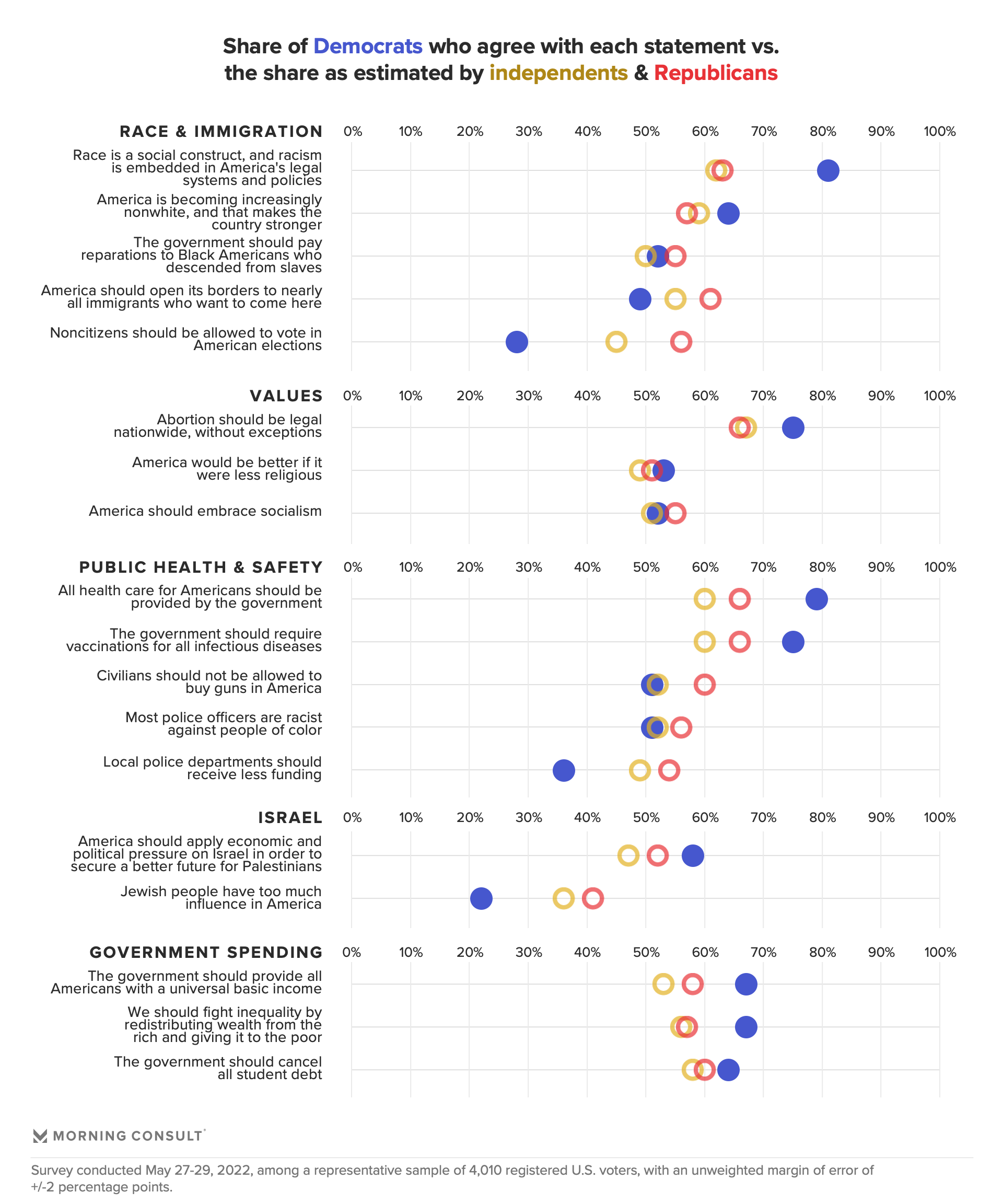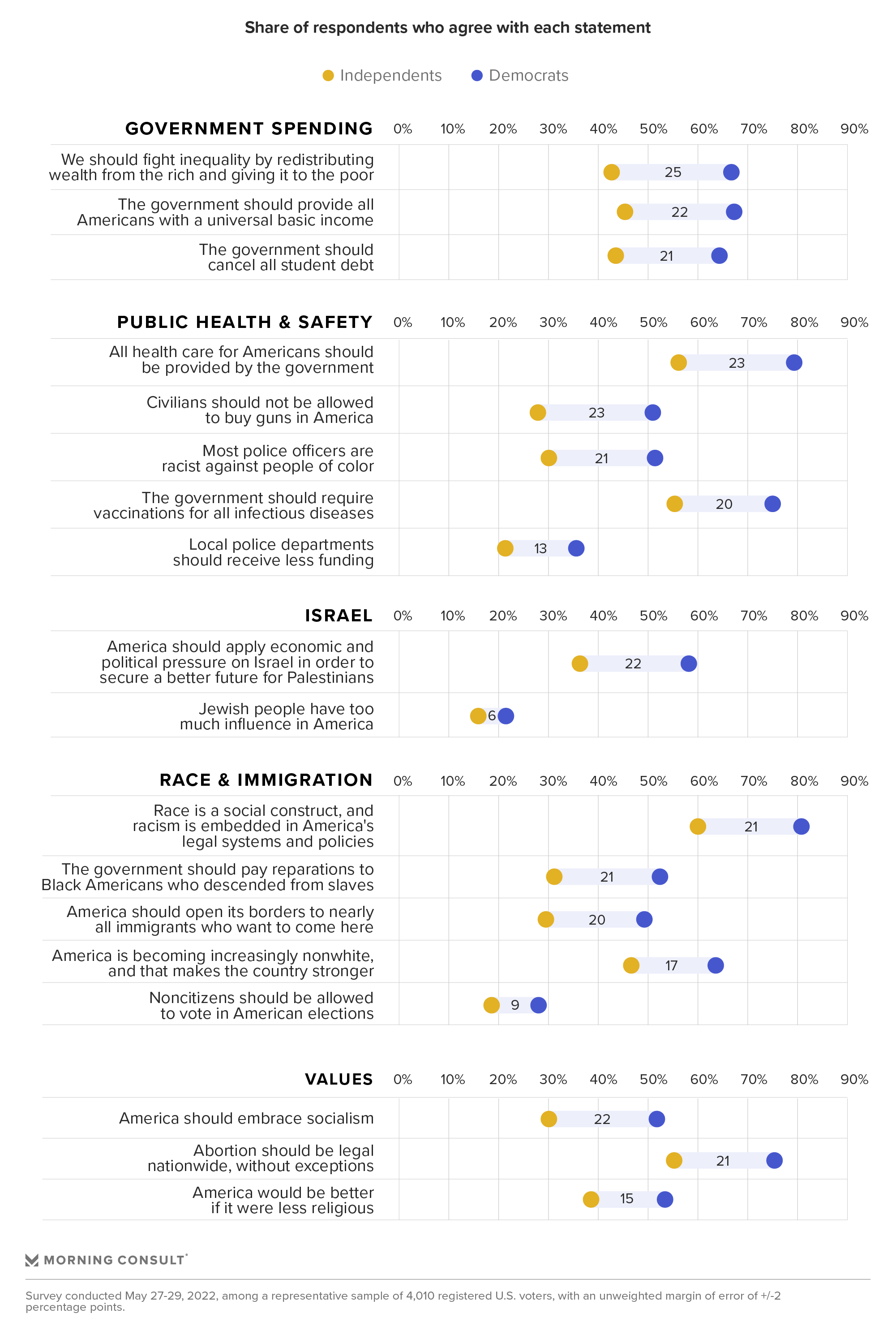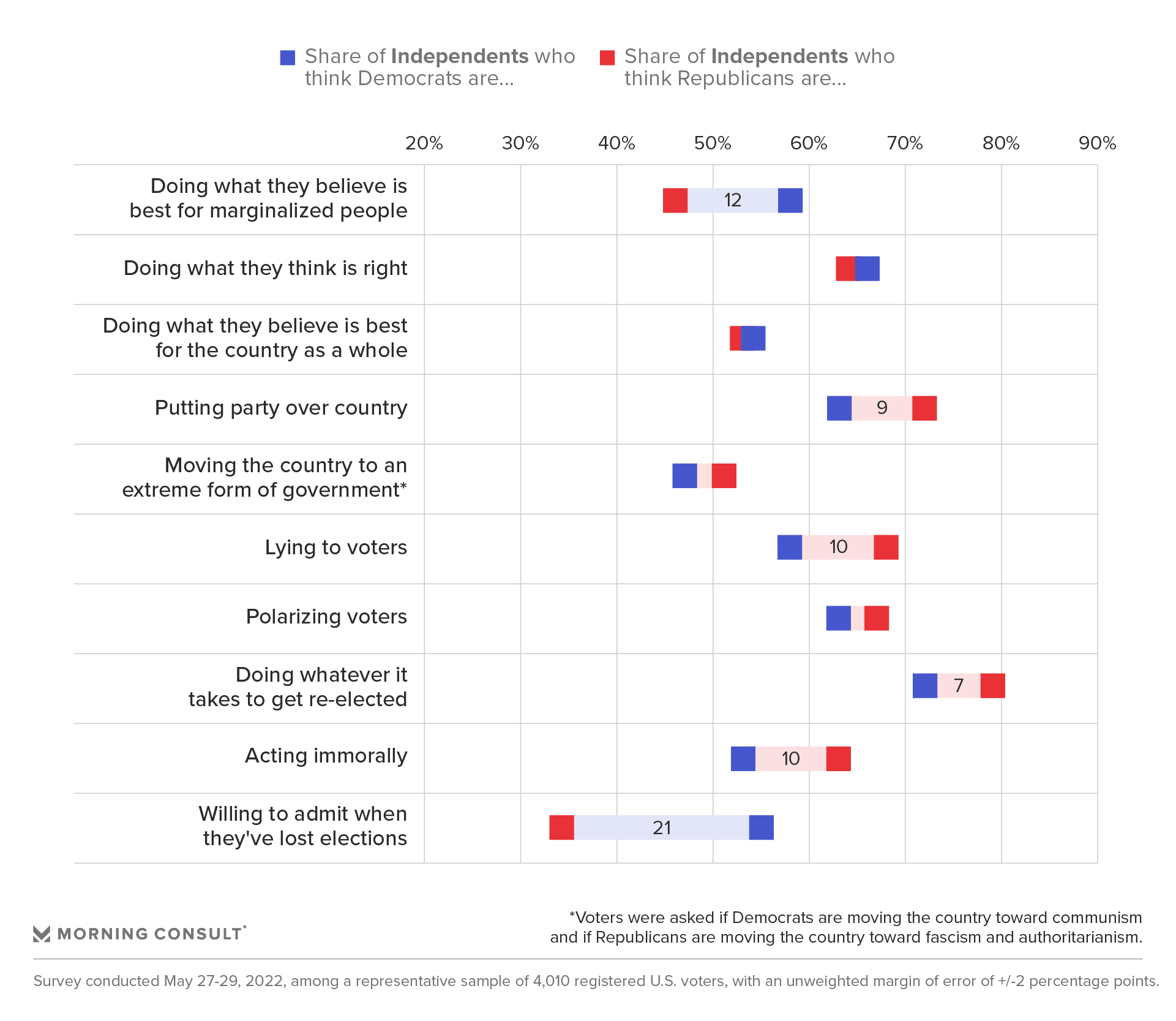Negative Partisanship Works in American Elections, but Whom Will It Help the Most in 2022?

Key Takeaways
Republican voters are more likely than Democrats to both see the other side’s voters and party overall as ideologically extreme.
Democratic voters were most likely to overestimate the share of Republicans who believe abortion should be illegal nationwide without exceptions, while GOP voters were most likely to overshoot the share of Democrats who believe non-U.S. citizens should be allowed to vote.
Independents generally view Republicans as worse actors in the country’s political system than Democrats.
American political rhetoric is angry, with figures on the right and left casting people on the other side of the divide as extremists, both in their beliefs and their tactics for taking power.
While cynicism about political opponents is not new, it has intensified as politicians have increasingly embraced negative partisanship as a surefire motivator of their respective bases, from President Donald Trump’s win in 2016 over a similarly unpopular opponent to the Democrats’ victories in 2018 and 2020 over Trumpism and the man himself.
But Trump’s diminished direct role on the political stage suggests Democrats will have a tougher time wielding negative partisanship to motivate their base for the stretch run of this year’s midterms. The tallness of that task is underscored by new Morning Consult research, which shows that voters on the right are more likely than those on the left to view the opposing side as ideologically extreme and acting in bad faith. However, Democrats may be able to find fruit in the Republican Party’s vocal extremes to motivate voters in the middle, who are more likely to see Republicans as a bigger threat to functioning democratic norms.
“Republicans will — and probably successfully so — seek to motivate their base by tapping into anger at Democrats’ perceived extremism,” said Steven Webster, an assistant political science professor at Indiana University. But pointing especially to independent voters, he added, “I also think that this tactic will be useful for Democrats.”
How voters gauge ideological extremism
On the campaign trail already, Democrats have tried painting their rivals as the embodiment of the far right: They started with messaging that the GOP was the “the party of QAnon” almost immediately after Biden took office, and later turned to describing their opponents as “ultra-MAGA Republicans” to highlight fealty to the GOP’s unpopular leader.
Republicans, meanwhile, are sticking with their tried-and-true “socialism” attack, which uses progressive lightning rods such as Sen. Bernie Sanders (I-Vt.) and Rep. Alexandria Ocasio-Cortez (D-N.Y.) to paint the broader Democratic Party — a relatively big tent with a patchwork of coalitions of varying ideology and interests — as extreme. This approach includes the typical arguments about the role the government should play in the life of everyday Americans, but it also seeps into attacks on divisive cultural topics such as LGBTQ rights, immigration policy and systemic racism.
In speaking to their respective bases, it’s Republicans who find a more receptive audience, as illustrated by a new survey experiment that measured ideological perceptions of each party and its voters. The survey asked voters to place themselves, the two parties and their respective voters on a 1-7 point ideological scale, where “1” means “very liberal,” “4” means “moderate” and “7” means “very conservative.”

Republican voters are more likely than Democrats to both see the other side’s voters and party overall as ideologically radical, but they actually place themselves further from the “moderate” center than Democrats do.
Matt Grossmann, director of the Institute for Public Policy and Social Research at Michigan State University, said Republicans in the electorate “aren't necessarily afraid” to own their ideological conservatism. In many ways it’s at the heart of their movement, and why the charge of being a “RINO” (shorthand for “Republican in name only”) is so present in GOP primaries.
While Republicans in turn are more likely to view their counterparts in the country as ideologically extreme, Grossmann said Democrats may very well judge the GOP on a different scale given Trump’s stray from traditional Reagan- and Bush-style conservatism.
“We convey the ideological spectrum as about extremity, but not all voters see it that way, and in particular I think Democrats might see things as extreme without seeing them as at the end of an ideological spectrum,” he said.
Democratic strategist and former Democratic Congressional Campaign Committee official Ian Russell said he’s experienced this dynamic in campaigns, with voters from his party’s base being generally more willing to cut Republicans some slack than vice versa.
“This has been a problem for a long time,” he said. “It got me reminiscing about Democratic voters who are educated and know the issues, but like the fact that they vote for the occasional Republican.”
“You don’t see Republicans giving Democrats that same benefit of the doubt very often,” he added.
The gap between what partisan voters believe and what the other side thinks they believe
Looking across the other side of the aisle, Democrats and Republicans are more likely to underestimate than overestimate just how widespread some sentiments are, including many outside the political mainstream.
The survey gave Democrats one list and Republicans another of roughly 20 statements and asked them whether they agreed or disagreed. Then, it asked members of the opposite party to estimate the share of Democrats and Republicans who believed them in a test designed to gauge just how close Americans of opposite political persuasions are to understanding their rivals’ beliefs.

On average, Democrats estimated with near accuracy the share of GOP voters who see no difference in a person’s gender and sex, or believe the country would be safer with more gun ownership. Similarly, Democrats almost pegged the share of Republicans who subscribe to the “white replacement” conspiracy theory that argues Western elites are seeking to make the electorate more diverse in order to weaken whites’ influence in America.
Democrats underestimated the share of Republicans who believe all Americans should be taxed at the same rate and overestimated the share who believe abortion should be illegal nationwide without exceptions.
With the Supreme Court having overturned the landmark 1973 Roe v. Wade decision — and a number of conservative state legislatures across the country having enacted absolutist abortion restrictions — abortion rights, in particular, look set to play a major role in Democrats’ messaging efforts between now and November.
On the other side of the aisle, Republicans, on average, accurately estimated the share of Democrats who believe America should embrace socialism and secularism — key issues in the right’s culture-driven campaign against Democratic control of Washington. On the other hand, they vastly overestimated the share of Democrats who agree that “Jewish people have too much influence in America,” a view sometimes alluded to by far-left political figures, or in the tenets of “defund the police” which most national Democrats have flatly rejected but has nonetheless been plastered on the airwaves by GOP candidates.
Webster said his research into negative partisanship has shown the gaps in understanding of the other side’s positions are often driven by the most conservative Republicans and the most liberal Democrats, whom other surveys have shown to be more enthusiastic about participating in elections than those with a less-developed ideology.
“The fact that partisans tend to overestimate what supporters of the opposing party believe is problematic because it can reinforce the growing negativity and antipathy that we’re seeing in American politics,” he said.
Where independents stand on the two parties
The relatively hardened positions of the Democratic and Republican parties raises the stakes for how the two parties are perceived by voters in the middle, a bloc that proved responsive to the negativity against Trump in the 2018 and 2020 campaigns but has soured on Biden and the Democrats who control Washington.
Independents — a just-right-of-center group who view the Republican Party as slightly more in line with their ideology than the Democratic Party — performed roughly as well as their partisan peers, on average, in estimating what either party believes. But intuitively, these voters were also fairly far away from the consensus Republican and Democratic positions.

Very few independents agree that America should open its borders to nearly all immigrants who want to come here or that civilians should not be allowed to buy guns in America, views that are held by roughly half of Democratic voters. Independents are even further away from the GOP when asked whether they believe the LGBTQ movement is corrupting children or that all immigrants who came into America illegally should be deported.
Despite these gaps, voters who associate with neither party generally view Republicans as worse actors in the country’s political system.

For example, independent voters were more likely to say the Republican Party than the Democratic Party is putting party over country, lying to voters, acting immorally or doing whatever it takes to get re-elected. That aligns them more closely with Democratic voters, who, despite being more likely than their GOP counterparts to give the other side the benefit of the doubt on whether they’re doing what they think is right or what is best for the country, have ardently negative views about what motivates the GOP.
So while independents may view Biden and congressional Democrats with increasing negativity, they also tend to view Republicans as a unique threat to a healthy democracy.
Russell, who’s working to elect a number of Democrats this year, said this offers his party a chance to make 2022 a choice between two parties rather than a traditional midterm referendum on the president and party in power.
“On one hand, voters are frustrated with a lot of things in their life and that’s inevitably going to impact the way you feel about the county. On the other hand, you have a party that’s increasingly extreme in its positions that is beholden to pleasing one man,” he said. “That gives us an opportunity: One of these two parties is going to be in control.”
But Republican strategist and former National Republican Congressional Committee official Matt Gorman described that type of messaging from the Democrats as ultimately too narrowly focused.
“You listen to the Democrats’ talk, from the president of the United States on down, it’s, ‘Republicans are extreme,’ or Biden’s favorite line: ‘It’s not your father’s Republican party.’” He said that characterization of the GOP may be internalized by parts of the electorate, but its effects were limited given this year’s broader political environment.
Still, while negative partisanship may not ultimately be enough to keep Democrats in control of both chambers of Congress past this year, the potential for another Trump presidential campaign would offer Democrats a head-to-head contrast in 2024 against his own extreme politics that helped them take power almost two years ago.
Eli Yokley is Morning Consult’s U.S. politics analyst. Eli joined Morning Consult in 2016 from Roll Call, where he reported on House and Senate campaigns after five years of covering state-level politics in the Show Me State while studying at the University of Missouri in Columbia, including contributions to The New York Times, Politico and The Daily Beast. Follow him on Twitter @eyokley. Interested in connecting with Eli to discuss his analysis or for a media engagement or speaking opportunity? Email [email protected].